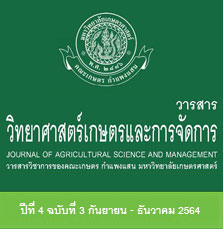Isolation of Cypermethrin-Degrading Bacteria from Agricultural Soil
Keywords:
cypermethrin, biodegradation, cypermethrin-degrading bacteriaAbstract
Cypermethrin is a widely used pesticide for pest control in crops. It is persistent to physical degradation, which results in the accumulation of contamination in the environment. Moreover, cypermethrin causes risks to human and animal health. In this study, cypermethrin degrading bacteria was isolated from agricultural soil that cypermethrin has been used for a long time. Cypermethrin-degrading bacteria 21, 16 and 15 isolates were obtained from celery, Chinese broccoli and cucumber planting soil, respectively. All the bacterial isolates were tested for cypermethrin degradation efficiency in a mineral salt medium (MSM) containing 100 mg/L of cypermethrin. It was found that 10 isolates showed degradation efficiency higher than 60% including A21, B1, B3, B6, B13, C8, C9, C10, C11 and C13. These bacteria were identified by 16S rRNA sequences analysis and classified into 6 different genera and 7 species including 5 known bacterial species: Acinetobacter baumannii, Azoarcus olearius, Phenylobacterium haematophilum, Pseudomonas nitroreducens, and Shinella zoogloeoides. Moreover, 2 genera were found to be new bacterial species including Pseudoxanthomonas and Pseudomonas. A. baumannii B3 had the highest efficiency in degradation of cypermethrin at 93% (3.8 mg/L of cypermethrin remaining) within 7 days. From our results, the cypermethrin-degrading bacteria could be developed into bacterial inoculum and application in bioremediation of cypermethrin-contaminated areas
References
โชติมา วิไลวัลย์. 2549. สารฆ่าแมลง. (ระบบออนไลน์). แหล่งข้อมูล: http://www.chemtrack.org/News-Detail.asp?TID=4&ID=4 (13 กรกฎาคม 2564).
Akbar, S., S. Sultan and M. Kertesz. 2015. Determination of cypermethrin degradation potential of soil bacteria along with plant growth-promoting characteristics. Current Microbiology 70: 75-84.
Akbar, S. and S. Sultan. 2016. Soil bacteria showing a potential of chlorpyrifos degradation and plant growth enhancement. Brazilian Journal of Microbiology 47: 563-570.
Ali, S.S., H. Mazhar and T. Riaz. 2011. Screening and characterization of cypermethrin degrading bacteria from polluted samples. Punjab University Journal of Zoology 26(1): 59-74.
Ashengroph, M., I. Nahvi, H. Zarkesh-Esfahani and F. Momenbeik. 2011. Pseudomonas resinovorans SPR1, a newly isolated strain with potential of transforming eugenol to vanillin and vanillic acid. New Biotechnology 28(6): 656-664.
Aswathi, A., A. Pandey and R.K. Sukumaran. 2019. Rapid degradation of the organophosphate pesticide-chlorpyrifos by a novel strain of Pseudomonas nitroreducens AR-3. Bioresource Technology 292: https://doi.org/10.1016/j.biortech.2019.122025.
Azmy, A.F., A.E. Saafan, T.M. Essam, M.A. Amin and S.H. Ahmed. 2015. Biodegradation of malathion by Acinetobacter baumannii strain AFA isolated from domestic sewage in Egypt. International Journal of Biological, Food, Veterinary and Agricultural Engineering 9(1): 55-65.
Bai, Y., Q. Sun, C. Zhao, D. Wen and X. Tang. 2009. Aerobic degradation of pyridine by a new bacterial strain, Shinella zoogloeoides BC026. Journal of Industrial Microbiology and Biotechnology 36: 1391-1400.
Chen, M.H., S.Y. Sheu, E.K. James, C.C. Young and W.M. Chen. 2013. Azoarcus olearius sp. nov., a nitrogen-fixing bacterium isolated from oil-contaminated soil. International Journal of Systematic and Evolutionary Microbiology 63: 3755-3761.
Cycon, M. and Z. Piotrowska-Seget. 2016. Pyrethroid-degrading microorganisms and their potential for the bioremediation of contaminated soil: a review. Frontiers in Microbiology 7: https://doi:10.3389/fmicb.2016.01463.
de Souza Rocha, A.F., L.C. Vitorino, L.A. Bessa, R.R. Guedes Fonseca Cost, M. da Silva Brasil and E.L. Souchie. 2020. Soil parameters affect the functional diversity of the symbiotic microbiota of Hymenaea courbaril L., a Neotropical fruit tree. Rhizosphere 16: https://doi.org/10.1016/j.rhisph.2020.100237.
Deng, F., J. Sun, R. Dou, X. Yu, Z. Wei, C. Yang, X. Zeng and L. Zhu. 2020. Contamination of pyrethroids in agricultural soils from the Yangtze River Delta, China. Science of the Total Environment 731: https://doi.org/10.1016/j.scitotenv.2020.139181.
Dua, M., A. Singh, N. Sethunathan and A.K. Johri. 2002. Biotechnology and bioremediation: successes and limitations. Applied Microbiology and Biotechnology 59: 143-152.
Faoro, H., R.R. Menegazzo, F. Battistoni, P. Gyaneshwar, F.P. do Amaral, C. Taulé, S. Rausch, P.G. Galvão, C. de los Santos, S. Mitra, G. Heijo, S. Sheu, W. Chen, C. Mareque, M.Z. Tadra-Sfeir, J.I. Baldani, M. Maluk, A.P. Guimarães, G. Stacey, E.M. de Souza, F.O. Pedrosa, L.M. Cruz and E.K. James. 2017. The oil-contaminated soil diazotroph Azoarcus olearius DQS-4T is genetically and phenotypically similar to the model grass endophyte Azoarcus sp. BH72. Environmental Microbiology Reports 9(3): 223-238.
Howard, A., M. O’Donoghue, A. Feeney and R.D. Sleator. 2012. Acinetobacter baumannii: an emerging opportunistic pathogen. Virulence 3(3): 243-250.
Huang, Y., L. Xiao, F. Li, M. Xiao, D. Lin, X. Long and Z. Wu. 2018. Microbial degradation of pesticide residues and an emphasis on the degradation of cypermethrin and 3-phenoxy benzoic acid: a review. Molecules 23: https://doi: 10.3390/molecules23092313.
Jabeen, F., M. Ahmed, F. Ahmed, M.B. Sarwar, S. Akhtar and A.A. Shahid. 2017. Characterization of cypermethrin degradaing bacteria: a hidden micro flora for biogeochemical cycling of xenobiotics. Advancements in Life Sciences 4: 97-107.
Lingens, F., R. Blecher, H. Blecher, F. Blobel, J. Eberspächer, C. Fröhner, H. Görisch and G. Layh. 1985. Phynylobacterium immobile gen. nov., sp. nov., a Gram-negative bacterium that degrades the herbicide chloridazon. International Journal of Systematic Bacteriology 35(1). 26-39.
Liu, S., K. Yao, D. Jia, N. Zhao, W. Lai and H. Yuan. 2012. A pretreatment method for HPLC analysis of cypermethrin in microbial degradation systems. Journal of Chromatographic Science 50: 469-476.
Liu, J. Y., Ding, L. Ma, G. Gao and Y. Wang. 2017. Combination of biochar and immobilized bacteria in cypermethrin-contaminated soil remediation. International Biodeterioration & Biodegradation 120: 15-20.
Shree, M. and P.R. Iyer. 2017. Degradation and bioremediation of the pesticide cypermethrin by Pseudomonas spp. and Bacillus spp. Journal of Chemical, Biological and Physical Sciences 8(1): 16-27.
Stackebrandt, E. and J. Ebers. 2006. Taxonomic parameters revisited: tarnished gold standards. Microbial Today 33: 152-155.
Wang, G., J. Zhang, L. Wang, B. Liang, K. Chen, S. Li and J. Jiang. 2010. Co-metabolism of DDT by the newly isolated bacterium, Pseudoxanthomonas sp. WAX. Brazilian Journal of Microbiology 41: 431-438.
Zhan, H., H. Wang, L. Liao, Y. Feng, X. Fan, L. Zhang and S. Chen. 2018. Kinetics and novel degradation pathway of permethrin in Acinetobacter baumannii ZH-14. Frontiers in Microbiology 2: doi: 10.3389/fmicb.2018.00098.
Zhang, B., H. Zhang, B. Jin, L. Tang, J. Yang, B. Li, G. Zhuang and Z. Bai. 2008. Effect of cypermethrin insecticide on the microbial community in cucumber phyllosphere. Journal of Environmental Sciences 20(11): 1356-1362.






